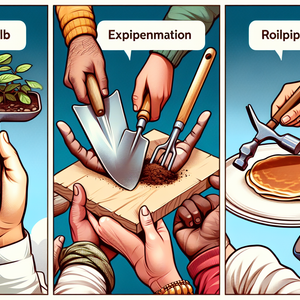The User-First Revolution: Designing Content with Empathy

Empathy is the cornerstone of user-first design. It begins with comprehensive research aimed at uncovering user motivations, pain points, and preferences. Techniques like user interviews, surveys, and usability testing provide invaluable insights into the user journey. For example, a company launching a new mobile app may conduct focus groups to grasp potential users' expectations and challenges. By actively listening to users, designers can tailor content that resonates, ensuring that each interaction effectively addresses user needs.
Supporting Examples
A notable instance is the process undertaken by Dropbox when they were refining their onboarding experience. They conducted user research to identify the initial hurdles new users faced when adopting the platform. By understanding that users felt overwhelmed by the features at first, Dropbox simplified their onboarding materials, creating a more approachable and user-friendly introduction to the service.
Empathy Mapping: A Useful Tool
Empathy mapping is a powerful tool within user-first design that allows teams to synthesize user insights and create a shared understanding of users' thoughts, feelings, and behaviors. An empathy map typically consists of four quadrants: what users say, think, feel, and do. By filling out this map, designers can pinpoint gaps in their content strategy and devise targeted solutions.
Supporting Examples
For instance, a tech company developing a complex software solution may realize through empathy mapping that users express confusion about certain features. By identifying this frustration, the team can prioritize creating content, such as tutorial videos or FAQs, that clarify usage and enhance user comprehension.
User Personas: Creating Relatable Characters
Creating user personas is another effective method for humanizing the design process. These fictional representations of target users help teams maintain focus on real user needs throughout the design and development process. Each persona should be rooted in research, encompassing demographic information, goals, challenges, and preferred content types.
Supporting Examples
For example, a persona for a fitness app might be "Health-Conscious Henry," a 28-year-old who seeks easy tracking of his workouts and dietary habits. By keeping Henry's needs in focus, designers can create engaging content, such as workout guides and nutrition tips, ensuring the final product aligns with his expectations and habits.
Real-World Examples of Empathy-Driven Content
Several companies exemplify the successful implementation of user-first design principles, resulting in heightened user satisfaction and loyalty.
Airbnb
Airbnb's platform is meticulously designed to cater to a diverse range of user needs. Whether travelers are searching for unique experiences or hosts are seeking advice on maximizing bookings, Airbnb prioritizes personalized content. By offering localized recommendations and tailored hosting tips, they demonstrate empathy for both guests and hosts. This approach not only enhances user engagement but also fosters loyalty, as users feel understood and valued.
Spotify
Spotify provides another remarkable example of empathy-driven content design. By leveraging user data to generate personalized playlists and recommendations, Spotify crafts content that aligns with individual listening habits and preferences. This tailored experience increases user retention and satisfaction, emphasizing the importance of understanding user behavior to foster a strong connection between users and the platform.
The user-first revolution in UX content design underscores the significance of empathy in creating meaningful user experiences. By grasping user needs, employing empathy mapping, and developing relatable personas, designers can craft content that resonates deeply with their audience. Real-world examples from companies like Airbnb and Spotify illustrate the transformative power of empathy-driven design, demonstrating that when users feel understood, they are more likely to engage with and return to a product. As we navigate the complexities of the digital age, prioritizing user empathy will be crucial for producing content that not only meets but exceeds user expectations. In this rapidly evolving digital landscape, the demand for professionals skilled in user-first design is surging. Opportunities abound for individuals to become UX content designers, product managers, and user researchers, all of which require a narrative structure skill set and a user-first perspective. By embracing these principles, aspiring professionals can contribute significantly to the user-first revolution, creating content that resonates and engages across diverse audiences.
UX Content Designer
Google, Facebook, smaller UX-focused agencies
Job Description
Develops user-centered content strategies that enhance user experience across digital platforms.
Collaborates with UX researchers and designers to translate user insights into compelling content that meets user needs.
Requires proficiency in content management systems and a strong understanding of user journey mapping.
User Researcher
Amazon, consulting firms specializing in user experience
Job Description
Conducts qualitative and quantitative research to gather insights into user motivations, behaviors, and challenges.
Designs and executes user interviews, surveys, and usability tests to inform design decisions.
Must possess strong analytical skills and familiarity with research tools like UsabilityHub or UserTesting.
Product Manager (User Experience)
Microsoft, Apple, emerging tech startups
Job Description
Oversees the development of products with a focus on creating seamless user experiences based on user feedback and research.
Works cross-functionally with design, engineering, and marketing teams to ensure product alignment with user needs.
Requires experience in agile methodologies and a solid understanding of UX principles.
Interaction Designer
IBM, Adobe, various digital design agencies
Job Description
Focuses on creating engaging interfaces that facilitate user interaction with products or services.
Works closely with UX designers and engineers to prototype and iterate on design solutions based on user feedback.
Requires proficiency in design tools such as Sketch, Figma, or Adobe XD, alongside a strong visual design background.
Digital Marketing Specialist (User-Centric)
Shopify, digital agencies, tech firms focused on customer experience
Job Description
Develops and implements marketing strategies that prioritize user engagement and satisfaction through targeted content.
Analyzes user data and behavior to tailor marketing campaigns that resonate with specific audience segments.
Skills in SEO, content management, and familiarity with analytics platforms like Google Analytics are essential.


